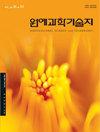基于SSR标记的湖南牡丹指纹图谱构建及遗传多样性分析
IF 0.8
4区 农林科学
Q3 HORTICULTURE
Korean Journal of Horticultural Science & Technology
Pub Date : 2021-10-01
DOI:10.7235/HORT.20210061
引用次数: 0
摘要
为了保护和鉴定牡丹品种,利用尾引物M13(TP-M13-SSR)技术构建了湖南省18个地方牡丹品种的DNA指纹图谱,并利用简单序列重复标记对其遗传多样性进行了分析。从131对多态性引物中筛选出24对具有稳定扩增和良好毛细管电泳峰的引物。8对引物的Shannon信息指数(I)、多态性信息含量(PIC)和分化率均高于平均水平。采用算术平均(UPGMA)树状图的未加权配对群方法,表明18个湖南牡丹品种的遗传相似系数在0.57~0.86之间,将牡丹‘宁香红’(0.57)分为一个单独的类群。用两对引物可以完全区分这18个品种。快速响应码中包含了品种名称、花型、指纹码等信息,为湖南牡丹品种的分子鉴定提供了依据。湖南牡丹品种DNA指纹图谱的构建对其保护具有重要意义。附加关键词:毛细管电泳、分子标记、快速反应(QR)码、带尾引物M13的简单序列重复(TP-M13-SSR)、算术平均的未加权配对群法(UPGMA)本文章由计算机程序翻译,如有差异,请以英文原文为准。
Fingerprint Construction and Genetic Diversity Analysis of Tree Peony Collected from Hunan Province Based on SSR Markers
To protect and identify the varieties of tree peony, DNA fingerprints were constructed and genetic diversity was analyzed with simple sequence repeat markers with tailed primer M13 (TP-M13-SSR) technology in 18 local tree peony varieties in Hunan Province of China. Twenty-four out of 131 pairs of polymorphic primers showing stable amplification and good capillary electrophoresis peaks were selected. The Shannon information indexes (I), polymorphism information contents (PICs), and differentiation rates of eight primer pairs were higher than average. Unweighted pair-group method with arithmetic mean (UPGMA) dendrograms indicated that the genetic similarity coefficients of the 18 Hunan tree peony varieties ranged from 0.57 to 0.86, and Paeonia suffruticosa ‘Ning Xiang Hong’ (0.57) was classified as a separate group. The 18 varieties could be completely distinguished with two pairs of primers. The variety names, flower types, fingerprinting codes, and other information were included in the quick response (QR) code, which provides a basis for the molecular identification of Hunan tree peony varieties. The construction of DNA fingerprinting of tree peony varieties in Hunan is important for its protection. Additional key words: capillary electrophoresis, molecular markers, quick response (QR) code, simple sequence repeat with tailed primer M13 (TP-M13-SSR), unweighted pair-group method with arithmetic mean (UPGMA)
求助全文
通过发布文献求助,成功后即可免费获取论文全文。
去求助
来源期刊
CiteScore
2.00
自引率
0.00%
发文量
0
审稿时长
1 months
期刊介绍:
Horticultural Science and Technology (abbr. Hortic. Sci. Technol., herein ‘HST’; ISSN, 1226-8763), one of the two official journals of the Korean Society for Horticultural Science (KSHS), was launched in 1998 to provides scientific and professional publication on technology and sciences of horticultural area. As an international journal, HST is published in English and Korean, bimonthly on the last day of even number months, and indexed in ‘SCIE’, ‘SCOPUS’ and ‘CABI’. The HST is devoted for the publication of technical and academic papers and review articles on such arears as cultivation physiology, protected horticulture, postharvest technology, genetics and breeding, tissue culture and biotechnology, and other related to vegetables, fruit, ornamental, and herbal plants.

 求助内容:
求助内容: 应助结果提醒方式:
应助结果提醒方式:


